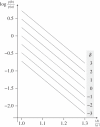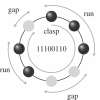Multistability, cross-modal binding and the additivity of conjoined grouping principles
- PMID: 22371617
- PMCID: PMC3282311
- DOI: 10.1098/rstb.2011.0365
Multistability, cross-modal binding and the additivity of conjoined grouping principles
Abstract
We present a sceptical view of multimodal multistability--drawing most of our examples from the relation between audition and vision. We begin by summarizing some of the principal ways in which audio-visual binding takes place. We review the evidence that unambiguous stimulation in one modality may affect the perception of a multistable stimulus in another modality. Cross-modal influences of one multistable stimulus on the multistability of another are different: they have occurred only in speech perception. We then argue that the strongest relation between perceptual organization in vision and perceptual organization in audition is likely to be by way of analogous Gestalt laws. We conclude with some general observations about multimodality.
Figures
















Similar articles
-
Multistability in perception: binding sensory modalities, an overview.Philos Trans R Soc Lond B Biol Sci. 2012 Apr 5;367(1591):896-905. doi: 10.1098/rstb.2011.0254. Philos Trans R Soc Lond B Biol Sci. 2012. PMID: 22371612 Free PMC article.
-
Bimodal moment-by-moment coupling in perceptual multistability.J Vis. 2024 May 1;24(5):16. doi: 10.1167/jov.24.5.16. J Vis. 2024. PMID: 38819806 Free PMC article.
-
Pupillometry in auditory multistability.PLoS One. 2021 Jun 4;16(6):e0252370. doi: 10.1371/journal.pone.0252370. eCollection 2021. PLoS One. 2021. PMID: 34086770 Free PMC article.
-
Smelling x as y? On (the impossibility of) multistable perception in the chemical senses.Conscious Cogn. 2025 Jul;132:103875. doi: 10.1016/j.concog.2025.103875. Epub 2025 May 7. Conscious Cogn. 2025. PMID: 40339447 Review.
-
To what extent do Gestalt grouping principles influence tactile perception?Psychol Bull. 2011 Jul;137(4):538-61. doi: 10.1037/a0022335. Psychol Bull. 2011. PMID: 21574680 Review.
Cited by
-
Multisensory constraints on awareness.Philos Trans R Soc Lond B Biol Sci. 2014 Mar 17;369(1641):20130207. doi: 10.1098/rstb.2013.0207. Print 2014 May 5. Philos Trans R Soc Lond B Biol Sci. 2014. PMID: 24639579 Free PMC article. Review.
-
Multistability in perception: binding sensory modalities, an overview.Philos Trans R Soc Lond B Biol Sci. 2012 Apr 5;367(1591):896-905. doi: 10.1098/rstb.2011.0254. Philos Trans R Soc Lond B Biol Sci. 2012. PMID: 22371612 Free PMC article.
-
Perceptuo-motor interactions in the perceptual organization of speech: evidence from the verbal transformation effect.Philos Trans R Soc Lond B Biol Sci. 2012 Apr 5;367(1591):965-76. doi: 10.1098/rstb.2011.0374. Philos Trans R Soc Lond B Biol Sci. 2012. PMID: 22371618 Free PMC article. Review.
-
Augmenting art crossmodally: possibilities and pitfalls.Front Psychol. 2025 Jul 14;16:1605110. doi: 10.3389/fpsyg.2025.1605110. eCollection 2025. Front Psychol. 2025. PMID: 40727046 Free PMC article. Review.
-
Bimodal moment-by-moment coupling in perceptual multistability.J Vis. 2024 May 1;24(5):16. doi: 10.1167/jov.24.5.16. J Vis. 2024. PMID: 38819806 Free PMC article.
References
-
- McGurk H., MacDonald J. 1976. Hearing lips and seeing voices. Nature 264, 746–74810.1038/264746a0 (doi:10.1038/264746a0) - DOI - DOI - PubMed
-
- Jack C. E., Thurlow W. R. 1973. Effects of degree of visual association and angle of displacement on the ‘ventriloquism’ effect. Percept. Mot. Skills 37, 967–97910.2466/pms.1973.37.3.967 (doi:10.2466/pms.1973.37.3.967) - DOI - DOI - PubMed
-
- Thurlow W. R., Jack C. E. 1973. Certain determinants of the ‘ventriloquism effect’. Percept. Mot. Skills 36, 1171–118410.2466/pms.1973.36.3c.1171 (doi:10.2466/pms.1973.36.3c.1171) - DOI - DOI - PubMed
-
- van Wassenhove V., Grant K. W., Poeppel D. 2007. Temporal window of integration in auditory-visual speech perceptions. Neuropsychologia 45, 598–60710.1016/j.neuropsychologia.2006.01.001 (doi:10.1016/j.neuropsychologia.2006.01.001) - DOI - DOI - PubMed
-
- Bertelson P., Vroomen J., de Gelder B. 2003. Visual recalibration of auditory speech identification: a McGurk aftereffect. Psychol. Sci. 14, 592–59710.1046/j.0956-7976.2003.psci_1470.x (doi:10.1046/j.0956-7976.2003.psci_1470.x) - DOI - DOI - PubMed
Publication types
MeSH terms
LinkOut - more resources
Full Text Sources

